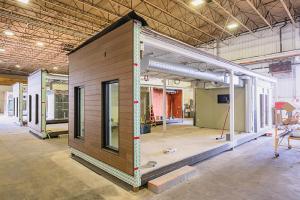Collaboration between construction and facilities management

Involving facilities managers in construction projects can help to avoid costly errors and delays.
Image from Getty Images
Collaboration between internal facilities management and construction management teams is essential for the success of any health care construction project. Whether it is a major capital investment led by the construction team or a smaller infrastructure or operational project overseen by facilities management, both groups must engage early in the planning phase. Being aligned and unified from the onset ensures construction efforts are consistent with long-term operational goals, operational disruptions are minimal and patient care remains uninterrupted throughout the process.
At the start of every project, it's critical to define leadership roles. Who is in the driver’s seat, construction or facilities management? This depends on the organization’s structure and policies. Effective role clarity streamlines communication with stakeholders and ensures all teams stay informed about the overall project, potential changes, risks and impacts to clinical operations.
Goals will vary across project types, whether it’s a new hospital, remodel, greenfield development or basic capital request. Forming strategies related to effective communication, role clarity, resource optimization and, most importantly, how to achieve an environment of care that supports both patients and staff is crucial to achieve the organization’s goals on a given project.
Role clarity and responsibilities
A successful project, at a minimum, is a project delivered on time and on budget, and it requires a collaborative approach among all project stakeholders. When this occurs, input and ideas from a specialized, dynamic group of stakeholders ensures that all needs and best practices are met. When every member understands their tasks and deadlines, projects can move forward with fewer interruptions and better support from all stakeholders. Poor communication often leads to costly errors and delays that could have been avoided. The benefit of a unified team is undeniable. While clarifying roles and expectations, it is important internal stakeholders also understand how they should be interacting with external stakeholders. Construction management should be the conduit to the external stakeholders identified below. This limits confusion and avoids potential unneeded changes in the project.
Planning, design and construction (PDC). PDC teams are responsible for managing the overall planning, design and construction of projects. Working closely with strategic leadership, their role is to ensure the physical environment aligns with the organization’s mission, vision and values and make sure the project stays within budget and follows all hospital specifications. PDC professionals have various roles throughout the project, but the construction management team should be involved from start to finish. The construction manager will serve as the project conductor, maintaining control over timelines, budgets, design standards and stakeholder communication. It is important the construction management team manages all internal communications to external stakeholders.
Facilities management. Facilities management teams manage the day-to-day operations and maintenance of health care facilities. They are responsible for life safety and the environment of care and keeping the facility functional and safe. Facilities management’s early involvement in projects is crucial, as they offer a perspective on operational needs and long-term maintenance. While construction management may lead large projects, facilities management plays a vital supporting role throughout the project.
Architecture. Architects bring the design vision to life, ensuring buildings are code-compliant, meet owner specifications and reflect current industry design and user-experience trends. They collaborate closely with general contractor to ensure the project is executed according to plan. Architects work with the PDC and facilities management teams, ensuring all hospital specifications are followed.
General contracting. The general contractor oversees the construction process and coordinates all subcontractors. In complex health care projects, they are often brought in early during the design phase to help maintain budget alignment and feasibility. Early involvement can result in significant cost savings. From schematic design through the duration of the construction project, the general contractor should be aligning with the architect and building owner, verifying costs at all stages of the project and communicating effectively with the team to stay ahead of any disruptions to schedule or potential change orders.
Other general project stakeholders. Other project stakeholders include consultants, inspectors and, most importantly, any individuals within the organization with interest in the PDC and future operations of the hospital. Often, these stakeholders will include multiple support departments, such as: information technology, environmental services, supply chain, marketing, patient experience and operational leaders and key contributors assigned from internal departments within a hospital.
Identifying project leadership
Large organizations with extensive portfolios of facilities tend to have one department responsible for construction and one department responsible for maintenance and operations. As a result, these two departments need to communicate effectively and work together closely to achieve successful projects.
What is a successful project? Besides project delivery being on time and on budget, a successful project is one that is patient-centered; improves staff workflow; meets all regulatory and compliance regulations and standards; and follows the institution’s policies, procedures and overall standards, including design standards. The list goes on. How does an organization achieve this? Effective communication collaboration. Construction and facilities management need to be aligned and support each other to be sure this happens.
In large health care systems, clearly defined leadership around projects is a nonnegotiable. Collaboration is clearly paramount when all heavily involved project stakeholders understand the scope, budget and their specific roles from day one. This clarity allows individuals to perform at the top of their expertise, resulting in a successful project. The construction management team needs to establish parameters and roles for all stakeholders so the project can run smoothly from kickoff.
When it comes to capital projects, the construction team typically manages the budget and schedule. Additionally, they must coordinate closely with facilities management to avoid scope creep, adds to the project and potential change orders. This can be a challenge when facilities management advocates strongly for specific equipment or features considered “wants” rather than “needs.” In some cases, these wants and needs may exceed the budget or not be included in the project for an underlying reason. It is important that facilities management understands the “why” behind what may not be included or placed in a certain area of the building. Early alignment helps mitigate these tensions and focus decisions on feasibility and long-term value. Telling facilities management and stakeholders where their support and input is needed is the secret recipe for success.
When it comes to infrastructure, such as utility upgrades or time-saving opportunities related to equipment location, do not overlook facilities management's input. Their involvement ensures critical infrastructure is prioritized appropriately and no key systems are missed, which could add costs to the project if not caught early on.
Collaboration doesn't just mean participating in general contractor-led meetings. Facilities management teams can enhance communication by organizing internal planning meetings with internal project stakeholders, such as shared services, clinical operations and department leadership, to keep everyone educated on all facets of the construction project within the hospital. This is extremely beneficial when it comes to various shutdowns, closures of areas within the hospital, parking-related information and more.
Another opportunity related to infrastructure and smaller projects is to have facilities management lead the project rather than construction management. These projects might be under a certain dollar amount, or maybe they are strictly related to roofing or heating, ventilating and air-conditioning (HVAC) equipment, etc. By enabling facilities management to lead these smaller projects, the construction management team can focus on larger capital projects and strategies.
Transition from construction to operations
A successful project handoff from construction management to facilities management begins early. When facilities management is involved from the beginning and through the entirety of the project, they are better prepared to operate workload from the construction management team. Many documents are passed to and from architects, general contractors, and subcontractors, such as drawings, specifications, operation and maintenance manuals, warranty information and commissioning reports that ultimately should be stored for the life of the building. The facilities management team can assist the construction management team in reviewing these documents and then storing them appropriately for future needs.
During the final project phase, facilities management should be included in the punch list walk-throughs. While some organizations leave this to the architect and general contractor, a joint walk-through involving construction management, facilities management and vendors leads to a better project at turnover. After the team’s punch list walk-through, the construction management team can generally allow for follow up to be handled by facilities management, meaning facilities management will monitor the punch list and report back to construction management.
Finally, construction management should coordinate owner training sessions with the general contractor and subcontractors. These sessions prepare facilities management teams with the knowledge needed to operate complex building systems such as HVAC, plumbing, electrical, building automation, medical gas, fire alarms and other specialized systems.
Getting off to a good start
Health care construction projects are very complex, requiring extensive planning among all stakeholders. These project types demand collaboration between construction and facilities teams. By establishing clear leadership parameters, encouraging early and ongoing involvement and creating a culture of open communication, organizations can prevent costly change orders and deliver facilities that are operationally excellent and provide quality patient care. When construction and facilities management work together closely from planning through post-occupancy, the result is a successful project and health care environment, ready to meet all patients’ needs.
Kyle Nelson, CHFM, CHC, is system director of facilities management and real estate at Hospital Sisters Health System.




